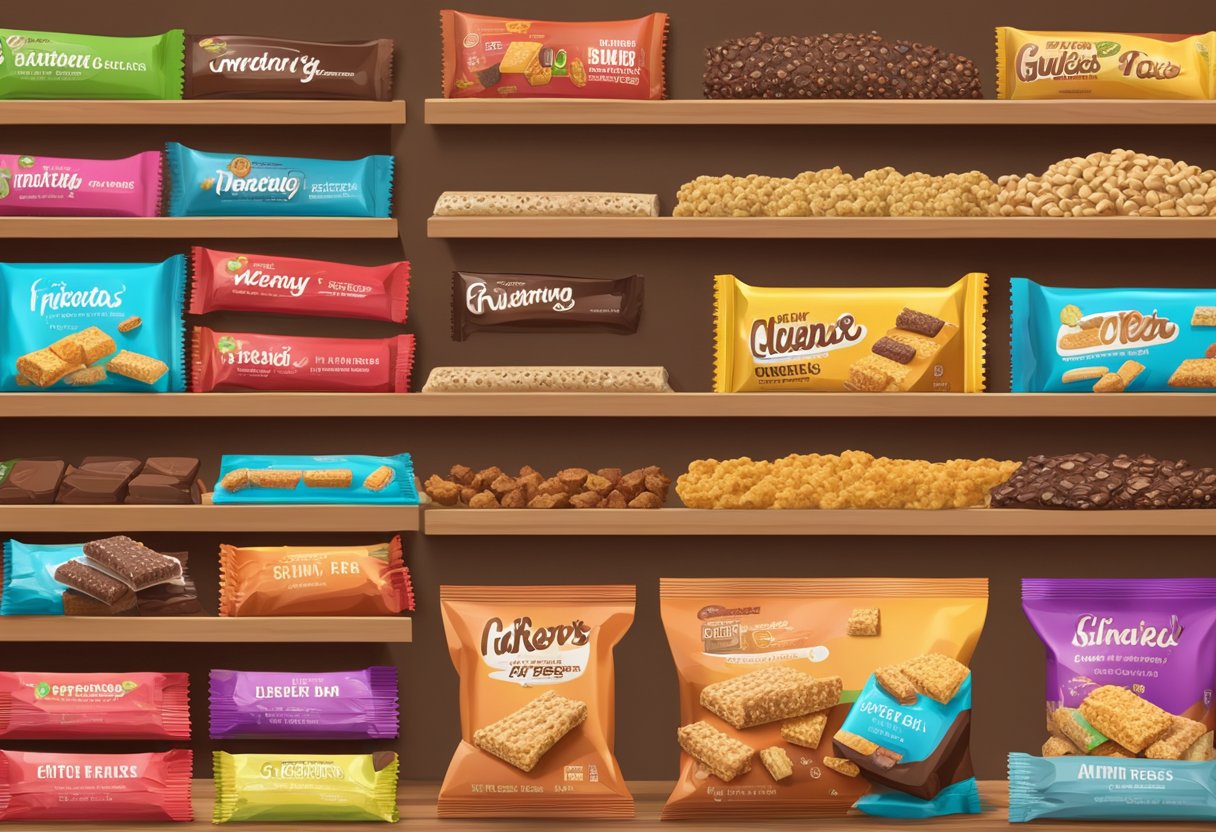Energy bars have become a staple for on-the-go nutrition, offering a compact source of energy for athletes, busy professionals, and health enthusiasts alike. Their popularity hinges on convenience and the promise of a quick nutritional boost. However, as gluten-free diets have gained traction due to health needs such as celiac disease or lifestyle choices, there’s a burgeoning market for gluten-free energy bars. These bars cater to those who require or prefer to avoid gluten, a protein found in wheat, barley, and rye, without sacrificing the convenience energy bars provide.

While energy bars can be part of a balanced diet, there’s a growing concern about distinguishing between genuinely healthy options and those that might be categorized as gluten-free ‘junk food’. The latter may be devoid of gluten, yet still high in sugars and low in nutritional value, emulating the issues of conventional junk food. Therefore, a discerning approach to selection is imperative. For individuals pursuing a gluten-free Mediterranean diet, which emphasizes fruits, vegetables, lean proteins, and whole grains, finding an energy bar that aligns with these dietary principles is essential. Gluten-free energy bars that draw on the wholesome aspects of Mediterranean ingredients can offer a nutritious and safe option.
Key Takeaways
- Energy bars are a convenient source of nutrition that now cater to gluten-free diets.
- It’s vital to distinguish between healthy gluten-free energy bars and those that are essentially junk food.
- Gluten-free Mediterranean diet principles can guide the selection of nutritious and fitting energy bars.
Table of Contents
Understanding Energy Bars
Energy bars are formulated to provide a convenient boost of energy from a combination of ingredients that can offer nutritional benefits. They are often utilized by people who need a quick source of energy and may cater to various dietary needs, including gluten-free options.
Fundamentals of Energy Bars
The primary purpose of energy bars is to deliver a compact and dense source of energy. Nutritional Value is a key factor, with a focus on balancing protein, healthy fats, vitamins, and minerals. Typically, they contain a mix of seeds such as chia seeds, pumpkin seeds, and flax seeds; nuts including almonds; as well as natural sweeteners like dates.
- Ingredients: Nuts, seeds, dried fruits, natural sweeteners
- Nutritional Value: Typically high in protein and fiber, with moderate healthy fats
Healthy Energy Bar Ingredients
Energy bars should contain whole food ingredients that are natural and minimally processed. For enhanced nutritional benefits, many bars incorporate organic materials that are non-GMO and include healthy fats from sources such as nuts. These contribute to the feeling of satiety and provide sustained energy.
List of Common Healthy Ingredients:
- Nuts: Almonds, walnuts
- Seeds: Chia, flax, pumpkin
- Fruits: Dates, apples
- Natural Sweeteners: Honey, maple syrup
Special Dietary Considerations
Dietary needs such as vegan, gluten-free, dairy-free, paleo, nut-free, egg-free, wheat-free, and grain-free are increasingly common and energy bars often cater to these requirements. Gluten-free options, crucial for individuals with celiac disease, avoid ingredients like wheat, barley, and rye. Substitutes can include nuts and seeds, which are inherently gluten-free and align well with a gluten-free Mediterranean diet.
Special Diets Energy Bars May Cater To:
- Gluten-Free: No wheat, barley, or rye; instead utilizing gluten-free grains or seeds
- Dairy-Free/Paleo: No milk products; often use nuts and seeds instead
- Vegan: Excludes all animal products; relies on plant-based proteins and fats
By ensuring that energy bars meet specific dietary constraints while providing essential nutrients, they can be a practical addition to one’s diet.
Energy Bar Selection and Consumption
Selecting and consuming the right energy bar involves understanding nutritional content, ingredient quality, and the optimal timing of consumption, considering the specific needs of an individual’s diet, such as the inclusion of whole food ingredients and the absence of gluten.
Choosing the Right Energy Bar
When selecting an energy bar, one should seek options that contain whole food ingredients such as nuts, seeds, and dried fruits. These components deliver healthy fats, protein, fiber, and essential minerals like calcium, magnesium, potassium, zinc, and vitamins, including vitamin C. For those following a gluten-free diet, ensuring the bars are certified gluten-free is crucial to avoid cross-contamination.
Reading Nutrition Labels
Nutrition labels on energy bars provide valuable information. Pay close attention to the ingredients list and the nutrition facts. A good energy bar should be high in fiber and protein and contain healthy fats. Bars with a short list of recognizable ingredients are often a healthier choice. However, beware of high sugar content, as some bars can be akin to dessert rather than a healthy snack.
Timing and Use Cases
Energy bars can be suitable as a quick breakfast, a pre- or post-workout boost, or a meal replacement when necessary. They should provide sustained energy, thanks to the presence of slowly digestible carbohydrates. However, their consumption should align with energy needs — a dense energy bar might be suitable for athletic endeavors but less so for sedentary activities.
Potential Health Benefits and Risks
While energy bars can be a convenient source of nutrients, they should not replace whole foods entirely. Those with a balanced blend of fatty acids may support heart health by potentially impacting cholesterol levels positively. Conversely, bars high in sugars and saturated fats pose health risks. It’s important to balance energy bar intake with a variety of foods, especially on a gluten-free Mediterranean diet, to ensure a wide range of nutrients are consumed.
Making Homemade Energy Bars

Homemade energy bars offer a nutritious, protein-packed snack that is perfect for on-the-go lifestyles and those following a gluten-free Mediterranean diet. They are not only easy to create but can also be customized with a variety of ingredients such as nuts, seeds, and dried fruit to fit individual dietary needs and taste preferences.
Basic Homemade Energy Bar Recipes
Creating gluten-free energy bars is simple, requiring no baking and just a handful of nutrient-rich ingredients. A base recipe might include rolled oats, Medjool dates for natural sweetness, and nuts like almonds or walnuts, all of which align with Whole30 and gluten-free dietary guidelines. To bind the ingredients and add a layer of flavor, one can use almond butter or sunflower butter, along with a splash of vanilla extract. Here is a basic recipe framework:
- 1 cup rolled oats (ensure gluten-free certification)
- 1/2 cup Medjool dates, pitted
- 1/2 cup almonds or walnuts, chopped
- 1/4 cup almond butter or sunflower butter
- 1 tsp vanilla extract
Combine these in a blender until well-mixed, then press into a lined baking dish and refrigerate.
Innovative Variations
To cater to different tastes and additional health benefits, one can introduce an array of innovative variations to the basic recipe. For a boost of antioxidants and a burst of fruity flavor, consider adding goji berries or dried blueberries. Chia seeds or hemp seeds offer extra protein and omega-3s, while dark chocolate chips provide indulgence without straying from the health-forward focus. Here’s a variation that gives a twist to the traditional energy bar:
- 1/2 cup pumpkin seeds for added zinc
- 2 tbsp cacao powder for a chocolatey taste
- A pinch of cinnamon for anti-inflammatory benefits
- 1/4 cup coconut oil to enhance texture and healthy fats
Mix these with the base ingredients for a diverse flavor profile.
Tools and Techniques for Preparation
The right tools and techniques ensure successful preparation of homemade energy bars. A high-powered blender or food processor is critical for combining ingredients into a consistent mixture. After blending, one should use a spatula to evenly spread the mixture into a freezer-safe dish. To set the bars, freezing is preferred over baking to maintain the integrity of heat-sensitive nutrients found in ingredients like honey and seeds. Once set, a sharp knife can be used to slice the bars to the desired size. Store the bars in the refrigerator to preserve freshness and maintain a chewy texture.
By following these tips and using the recommended tools, individuals can easily create their own homemade, gluten-free energy bars that are not just tasty but also aligned with a healthy Mediterranean lifestyle.
Commercial Energy Bars

Energy Bars have become a staple for quick nutrition, appealing to those on-the-go or following specific dietary guidelines. These bars offer a convenient energy boost and often cater to a range of dietary preferences, including the increasingly popular gluten-free Mediterranean diet.
Popular Energy Bar Brands
Several brands stand out in the market for their quality and selection of gluten-free energy bars. Some of the leading names include:
- RXBAR: Known for simple ingredients and transparency, RXBAR labels feature a clear list of the core components like dates, nuts, and egg whites.
- GoMacro: GoMacro bars emphasize organic, plant-based ingredients that are non-GMO and free from common allergens.
- Square Bar: These bars are marketed as organic and gluten-free, often layered with chocolate coating and boasting natural protein sources.
- Rise: Offering a minimalist approach, Rise bars consist of up to five ingredients, always emphasizing the use of whole foods.
Understanding Labels and Claims
It’s imperative for consumers to read labels carefully:
- Gluten-Free: Products such as gluten-free energy bars should be certified to ensure safety for those with celiac disease or gluten intolerance.
- Kosher and Vegan: Look for certification symbols if these dietary laws align with personal preferences.
- Paleo: Energy bars labelled as Paleo-friendly avoid grains, dairy, and legumes, and instead, rely on nuts, seeds, and dried fruits.
Artificial Additives and Preservatives
When considering natural and organic food options, one must scrutinize the ingredients for:
- Preservatives: Some energy bar brands add preservatives to prolong shelf life, which may not align with a natural diet.
- Artificial Additives: Colorants or flavor enhancers are sometimes used, and checking labels helps avoid these if desired.
By choosing bars with organic, non-GMO ingredients, one not only supports sustainable agriculture but also consumes products closer to the basics of the Mediterranean diet, which favors natural over processed foods.
Social Aspects and Trends
In the realm of nutrition and dietary preferences, there is a prominent social trend gravitating towards health-conscious snacking, with a particular interest in gluten-free and organic options. Energy bars have become a symbol of this shift, often discussed across various platforms for their convenience and health benefits.
Energy Bars in Social Media
Energy bars have seen a significant rise in popularity on platforms like Instagram. They are often marketed not only as a quick source of nutrition but also as a lifestyle choice that aligns with an active and health-aware image. Influencers frequently showcase gluten-free energy bars as part of their fitness routines or as a snack that fits into a Mediterranean diet, which is rich in healthy fats and whole foods. Entrepreneurs are capitalizing on the demand for organic and gluten-free options, creating energy bars that not only provide functional nutrition but also cater to the evolving dietary restrictions and preferences of their customers.
Instagram posts often feature visually appealing arrangements of energy bars with fruits, nuts, and seeds—ingredients commonly found in a Mediterranean diet—to highlight their natural and nutritious profiles. The visual allure of these posts reflects a society where food is not only about sustenance but also about aesthetics and lifestyle statements.
Nutrition and Health Considerations
When considering energy bars and gluten-free junk food, it’s essential to evaluate their nutritional value, potential allergens, and the sustainability of their ingredients. These factors play crucial roles in their impact on health and the environment.
Macro and Micronutrient Profile
Energy bars are often praised for their convenience and nutrient-rich profile, offering a blend of protein, fiber, and healthy fats. When it comes to gluten-free options, the challenge is maintaining this balance while omitting certain grains. For instance, gluten-free energy bars may include whole food ingredients such as dried fruits, seeds like chia or flaxseed, which are high in omega-3s, and oats that are certified gluten-free. These ingredients contribute to a well-rounded profile of vitamins and minerals without the need for additives.
- Protein: Sources can include nuts, seeds, or plant-based protein powders.
- Fiber: Often derived from fruits, nuts, and gluten-free whole grains.
- Healthy Fats: Typically found in nuts and seeds; provide satiety and support metabolism.
- Vitamins & Minerals: Essential for overall health, sourced from a variety of fruits, seeds, and nuts.
Energy Bars and Allergies
For individuals with food sensitivities or allergies, many energy bars are now catered to a wide scope of dietary needs, including being nut-free, egg-free, wheat-free, grain-free, and dairy-free. Manufacturers often highlight gluten-free labeling and ensure cross-contamination risks are minimized. If an energy bar is labeled as gluten-free, this typically means it has been tested and contains less than 20 parts per million of gluten, the threshold set by regulating authorities for gluten-free products.
Sustainable Practices and Ingredients
Consumers are increasingly interested in the environmental impact of their food choices, including the sustainability of ingredients and practices used in production. Organic, natural, and non-GMO labels are common indicators of healthy and sustainable practices, although they may also affect product cost. For instance, the incorporation of ingredients like organic dates powder and jaggery, sourced sustainably, can enhance the nutritive value while also supporting eco-friendly agriculture. Manufacturers might also prioritize renewable energy in production or biodegradable packaging to minimize environmental impact.
Conclusion

Energy bars have become a staple in contemporary diets, especially for individuals seeking convenient, on-the-go nutrition. However, not all energy bars are created equal. When considering gluten-free alternatives, consumers face a variety of products, which can sometimes fall into the category of gluten-free junk food. These items may lack essential nutrients while being high in sugars and fats, contrary to the benefits of a balanced gluten-free Mediterranean diet.
The gluten-free Mediterranean diet focuses on whole foods, such as fruits, vegetables, legumes, nuts, seeds, and whole grains, while avoiding processed items and refined sugars. Gluten-free energy bars should align with these principles to be considered part of a health-conscious diet. When selecting an energy bar, individuals must scrutinize the ingredients and nutritional content, aiming to choose bars that include:
- Dried fruits and nuts
- Seeds and oats
- Natural sweeteners like dates powder
| Nutrient | Desired Content |
|---|---|
| Fibers | High |
| Sugars | Low |
| Proteins | Adequate |
It is essential to examine the proximate analysis of energy bars, which encompasses moisture, ash, fiber, fat, and protein content. This ensures the energy bars are nutritionally favorable and align with the dietary practice of minimizing processed foods, which is a cornerstone of the Mediterranean diet. Gluten-free energy bars can be a healthy alternative when they deliver nutritious food to the consumer with a sensible balance of ingredients reflecting the dietary qualities of the Mediterranean region.
Frequently Asked Questions

When selecting gluten-free options, consumers often have questions regarding taste, nutrition, and preparation. Here are straightforward answers to common inquiries about gluten-free energy bars and junk food snacks.
What are the top-rated gluten-free energy bars?
Bumble Bar Organic Energy Bars and No Nuts Nut Free Protein + Energy bars are among the highly rated options that are safe for individuals with celiac disease. They focus on using simple, natural ingredients.
How can I find gluten-free energy bars with low sugar content?
Consumers can look for energy bars that use natural sweeteners like brown rice syrup, and read nutritional labels to check the sugar content. Avoiding bars with added sugars or sugar alcohols will help maintain a healthier diet.
Can you provide a recipe for homemade gluten-free energy bars?
One may make their own energy bars by combining gluten-free oats, nuts, seeds, honey, and dried fruit. They should press the mixture into a pan, bake until set, and cut into bars.
What are some safe gluten-free junk food snack options?
Certain chocolate brands like Hershey’s and Reese’s Cups offer gluten-free products. Consumers should still check the labels to ensure these treats fit into their dietary requirements.
What ingredients should I avoid in gluten-free energy bars to maintain a healthy diet?
Avoid ingredients such as soy protein concentrate, sugar alcohols (like Maltitol, Mannitol, Sorbitol, Xylitol), and excessive sweeteners. Choosing bars with whole food components such as seeds and nuts will support a healthier lifestyle.
Are there any Clif Bar flavors that are certified gluten-free?
Currently, Clif Bar does not provide flavors that are certified gluten-free, so those adhering to a gluten-free diet should consider other brands specifically certified or labeled as gluten-free.



